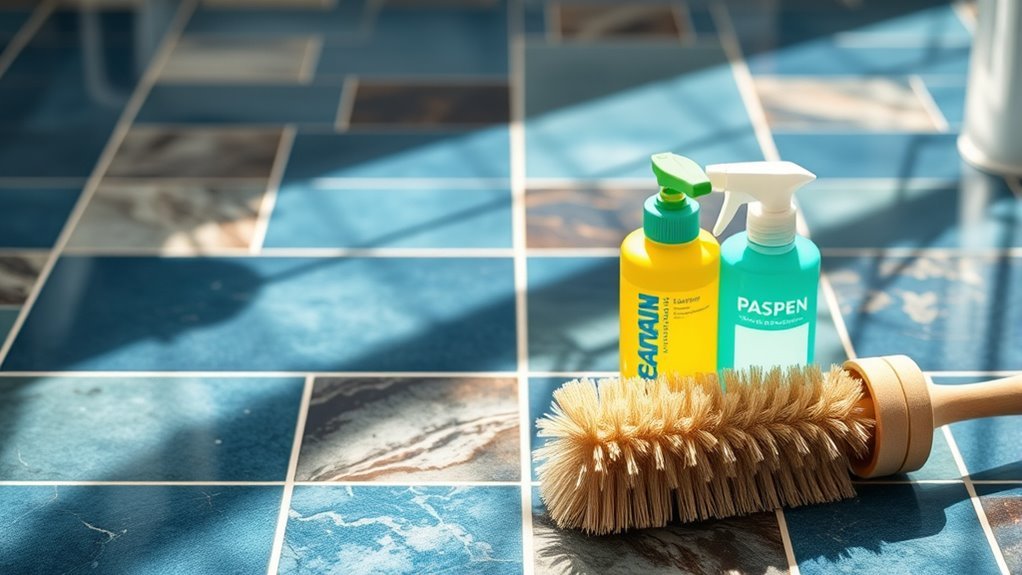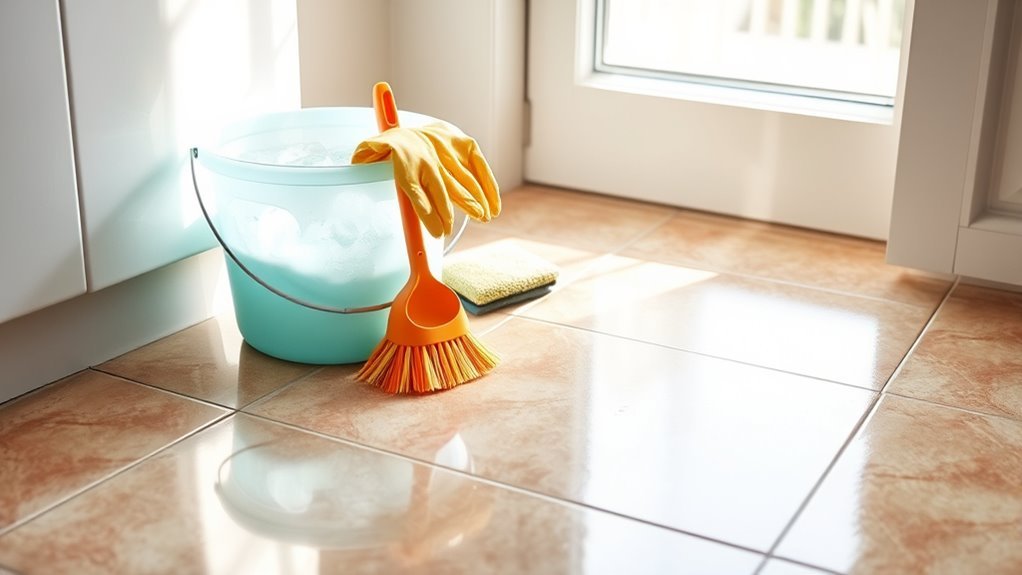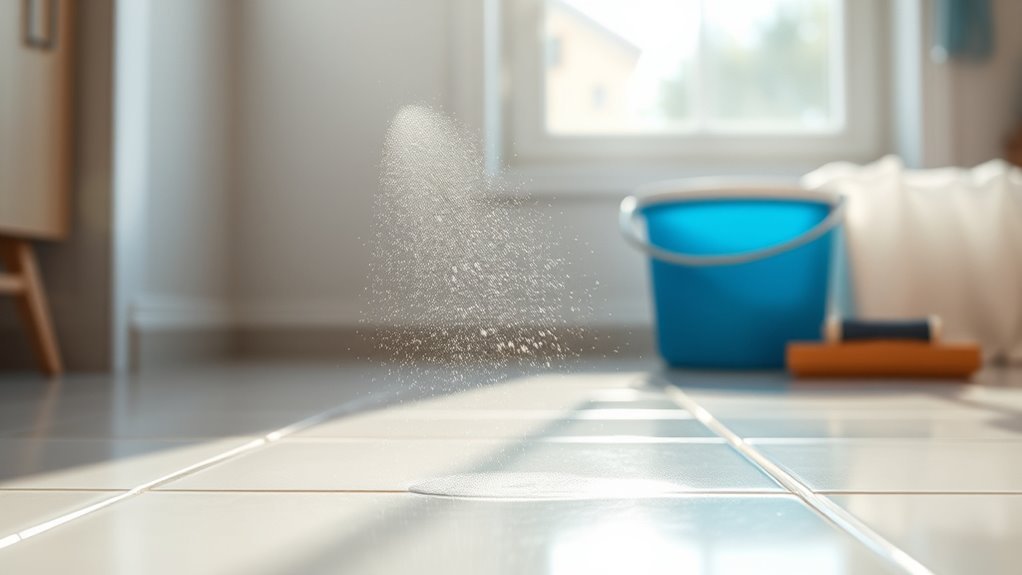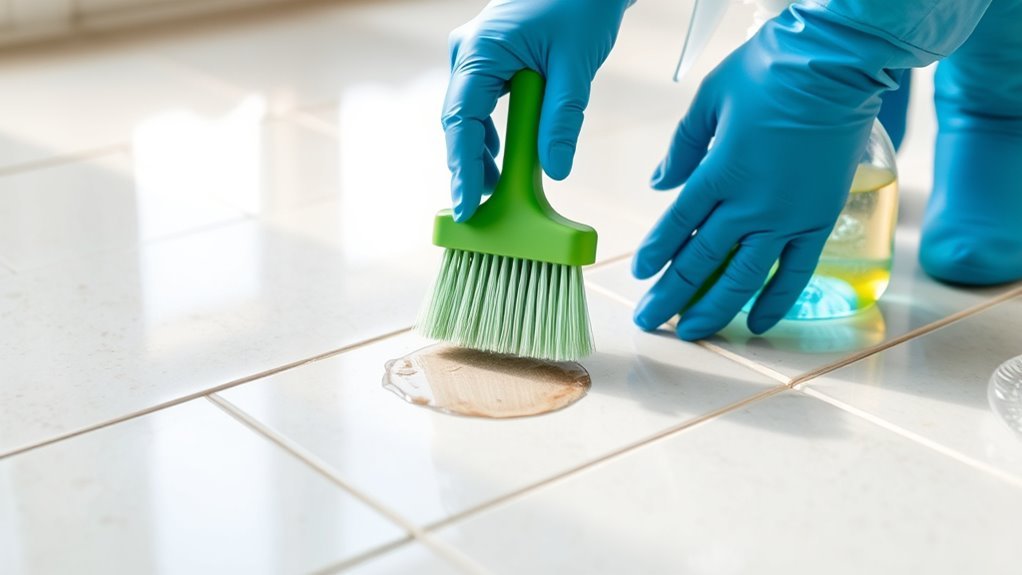How to Clean Tile
To clean your tile effectively, first remove loose dirt using a broom or vacuum. Choose a cleaner suited for your tile type—avoid acidic solutions on natural stone and pick pH-neutral formulas instead. Apply the cleaner with a soft mop or sponge, rinse thoroughly, and dry with a microfiber cloth to prevent streaks. For stubborn stains, try baking soda paste or steam cleaning. Keep grout clean with stiff brushes and sealants. There are more expert tips to help you maintain your tile’s pristine look.
Choosing the Right Cleaning Products for Your Tile

Before you begin cleaning your tile, it’s essential to select the right products tailored to your tile’s material and finish. You’ll want to balance product effectiveness with eco friendly options to maintain both cleanliness and environmental responsibility. For natural stone tiles, avoid acidic cleaners that can damage the surface; instead, choose pH-neutral formulas designed specifically for stone. Ceramic and porcelain tiles tolerate stronger solutions, but you should still opt for biodegradable, non-toxic cleaners to protect your health and freedom from harsh chemicals. Always check product labels for compatibility with your tile type, and consider concentrated formulas that reduce waste. By choosing the right cleaning agents, you guarantee your tile remains pristine without compromising your values or the planet’s well-being.
Preparing the Tile Surface for Cleaning
Selecting the right cleaning products sets the stage for effective tile maintenance, but preparing the surface properly guarantees those products work to their full potential. Begin with thorough surface preparation by removing loose dirt, dust, and debris using a broom or vacuum designed for hard floors. This prevents scratching and ensures cleaning agents penetrate grout and tile evenly. Next, inspect the tile for stains, mold, or damage; addressing these early avoids spreading contaminants during cleaning. Clear the area of furniture or mats to access every inch. Finally, test your chosen cleaning product on a small, inconspicuous tile section to confirm compatibility. Proper surface preparation is the foundation of successful tile maintenance, enabling you to achieve a pristine finish with less effort and longer-lasting results.
Step-by-Step Process to Clean Tile Floors and Walls

Cleaning tile floors and walls effectively involves a clear, methodical approach to guarantee every surface is spotless without causing damage. Start by sweeping or vacuuming to remove loose dirt and debris. Next, prepare a mild cleaning solution suited for your tile type, avoiding harsh chemicals that can impair tile maintenance. Use a soft mop or sponge to apply the cleaner evenly, paying attention to grout lines. Rinse thoroughly with clean water to eliminate residue, preventing dullness and buildup. Dry the surfaces with a microfiber cloth to avoid streaks and water spots. For consistent floor care, establish a routine cleaning schedule, addressing spills promptly. Following these steps assures your tiles stay pristine while preserving their longevity and your freedom from frequent deep cleans.
Effective Methods for Removing Stubborn Stains
Three key approaches can tackle stubborn stains on tile surfaces effectively, ensuring you restore their original appearance without causing damage. First, apply targeted stain removal techniques like a baking soda paste or hydrogen peroxide for organic stains, allowing them to sit before scrubbing gently. Second, employ deep cleaning methods such as steam cleaning, which penetrates grout and tile pores, loosening embedded dirt without harsh chemicals. Third, use commercial tile cleaners formulated specifically for your tile type, following instructions precisely to avoid surface etching. Always test any method on a small, inconspicuous area first. By combining these strategies, you maintain your tile’s integrity while achieving a thorough, stain-free finish, empowering you to keep your space fresh and vibrant with confidence.
Tips for Cleaning Tile Grout

To keep your tile grout looking fresh, you’ll need the right cleaning solutions tailored for grout’s porous texture. Using specialized tools like stiff-bristled brushes can effectively remove dirt without damaging the grout lines. Additionally, applying sealants regularly will help prevent stains and make future cleaning much easier.
Grout Cleaning Solutions
A well-chosen grout cleaning solution can make all the difference when restoring your tile’s appearance. You can select from natural solutions that are eco-friendly and gentle, or commercial cleaners that offer powerful stain removal. Knowing which to use depends on your grout’s condition and your preference for chemical use.
| Solution Type | Key Ingredients | Best For |
|---|---|---|
| Baking Soda Paste | Baking soda, water | Mild stains, everyday use |
| Vinegar Solution | White vinegar, water | Mold, mildew, light stains |
| Commercial Cleaner | Oxygen bleach, surfactants | Heavy stains, deep cleaning |
| Hydrogen Peroxide | Hydrogen peroxide | Disinfection, whitening |
| Steam Cleaning | Steam | Chemical-free, tough grime |
Choose wisely to maintain grout integrity and freedom from harsh chemicals.
Tools for Grout Care
Selecting the right grout cleaning solution is only part of the process; having the proper tools will greatly improve your results. For effective grout cleaning, you’ll need a stiff-bristled grout brush to target dirt lodged deep within the lines. Avoid wire brushes, which can damage grout. A handheld scraper or putty knife helps remove stubborn grime without scratching tiles. Microfiber cloths are essential for wiping away residue and moisture, ensuring a spotless finish. Additionally, a spray bottle allows even application of your cleaning solution, maximizing contact time. For ongoing upkeep, invest in maintenance tools like a steam cleaner, which uses high heat to sanitize grout without harsh chemicals. With these precise, durable tools, you gain the freedom to maintain your grout’s cleanliness efficiently and confidently.
Preventing Grout Stains
Grout stains can quickly undermine the appearance of your tile, but you can greatly reduce their occurrence by adopting consistent preventive measures. Prioritize grout sealing as a critical step; it creates a protective barrier that repels moisture and dirt, essential for effective stain prevention. Regular cleaning prevents buildup that leads to discoloration. Avoid harsh chemicals that erode sealants. Here’s a focused guide:
| Preventive Action | Nutzen |
|---|---|
| Grout Sealing | Creates water and stain barrier |
| Frequent Cleaning | Removes dirt before staining |
| Use pH-neutral Cleaners | Maintains seal integrity |
| Prompt Spill Cleanup | Prevents deep stain absorption |
Preventative Measures to Keep Tiles Looking New
Although regular cleaning is essential, taking preventative measures can greatly extend the life and appearance of your tiles. Start by implementing regular maintenance routines—sweeping and mopping frequently to prevent dirt buildup and abrasive particles from scratching the surface. Applying protective coatings designed for your tile type creates a durable barrier against stains, moisture, and wear. These coatings not only preserve the tile’s natural shine but also simplify future cleaning tasks. Be mindful of spills and clean them promptly to avoid permanent damage. Use floor mats in high-traffic areas to reduce dirt and grit accumulation. By embracing these proactive steps, you maintain the pristine look of your tiles, ensuring they remain a long-lasting, attractive feature in your space without sacrificing your freedom to enjoy your home.
Häufig gestellte Fragen
Can Tile Cleaning Damage Underfloor Heating Systems?
You might wonder if your tile maintenance could secretly harm your underfloor heating system. The truth is, with careful cleaning methods, you won’t damage it. Avoid soaking tiles excessively or using harsh chemicals that seep through grout and affect heating elements. Proper tile care guarantees your system stays efficient and your floors remain beautiful, giving you freedom to enjoy warmth without worry. Stay precise and gentle—your underfloor heating will thank you.
How Often Should Tile Seals Be Reapplied?
You should reapply tile seals every 1 to 3 years, depending on foot traffic and exposure to moisture. Regular seal maintenance is vital to protect grout and tiles from stains and damage. To guarantee effective seal application, test water absorption periodically—if water soaks in quickly, it’s time to reseal. Staying on top of this lets you maintain freedom from costly repairs, keeping your tiled surfaces looking fresh and durable.
Are Steam Cleaners Safe for All Tile Types?
Think of your tiles as delicate dancers—each material moves differently under pressure. Steam cleaner effectiveness hinges on tile material compatibility; porcelain and ceramic usually handle steam well, but natural stones like marble or travertine might suffer damage from high heat and moisture. You’ll want to check manufacturer guidelines before using steam, ensuring your cleaning method sets you free from dirt without trapping you in costly repairs.
Can Natural Stone Tiles Be Cleaned With Vinegar?
You shouldn’t use vinegar on natural stone tiles because its acidity can etch and dull the surface. For effective stone tile care, opt for pH-neutral cleaners specifically designed for natural stone. If you’re looking for vinegar alternatives, consider diluted mild dish soap or specialized stone cleaning solutions. These options keep your tiles safe while maintaining their beauty, giving you the freedom to clean confidently without damaging your stone surfaces.
What Is the Best Way to Dry Tiles After Cleaning?
Oh sure, just let your tiles air-dry forever—because who doesn’t love a soggy floor? Instead, you’ll want to master drying techniques that actually work. Grab microfiber towels or a squeegee as your drying tools; they quickly whisk away moisture, preventing streaks and water spots. You’re free to choose, but these tools guarantee your tiles dry fast and flawless, giving you not just clean, but confidently dry surfaces every time.






